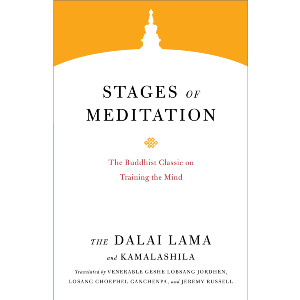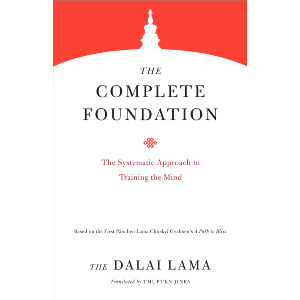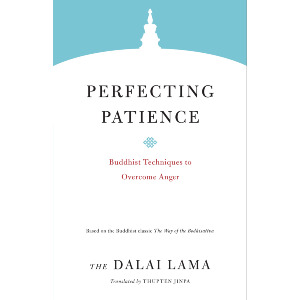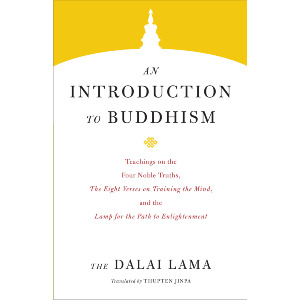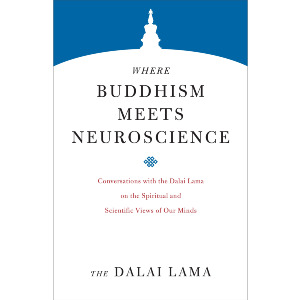An excerpt from Stages of Meditation
The Way to Meditate on Compassion
Compassion is one of the major causes for realizing the state of omniscience. It is important at the beginning of the practice, during the practice, and even after realizing the results of our spiritual endeavor. Now the question is: How should we meditate on it?
The way to meditate on compassion will be taught from the outset. Begin the practice by meditating on equanimity. Try to actualize impartiality toward all sentient beings by eliminating attachment and hatred.
Compassion is a mind that focuses on the sentient beings that are miserable and wishes them to be free from suffering. Compassion can be of three types, depending on the aspect of wisdom that accompanies it. These three are: compassion focused on sentient beings, compassion focused on phenomena, and compassion focused on the unapprehendable. All three are the same in being minds that earnestly desire sentient beings to be free from their misery. They are distinguished not in terms of their aspect, but in terms of their object of focus, because all three have the same aspect of wishing sentient beings to be separated from suffering. Compassion focused on sentient beings is so-called because it focuses merely on sentient beings without specifying their characteristics of being impermanent or empty of inherent existence. Compassion focused on phenomena refers to that compassion which not only focuses on sentient beings, but also focuses on sentient beings characterized by impermanence. Likewise, compassion focused on the unapprehendable refers to that compassion which focuses on sentient beings characterized by the unapprehendable, or their lack of inherent existence.
When we look at it from another angle, the merit of generating a kind thought is obvious. This is true whether you believe in a particular religion or not. A person’s general goodness is in direct correlation to the force, or quality, of the kind thoughts he or she generates. A kind person finds a lot of admirers, and they feel close to such a person. We can observe this phenomenon even among animals. Animals exhibit great joy and delight when they see people who are kind to them. And they enjoy being around such persons. Conversely, people who are aggressive and hold evil designs are regarded with suspicion even by animals and birds. Animals and birds run away when they hear their voices or even their footsteps. Therefore, a kind motivation or a kind heart is an extremely valuable quality.
People who possess compassion are amiable to all and their pleasing nature attracts friends everywhere. It is easy to observe the attraction of their compassionate motivation when we notice even strangers taking delight in their company. Let us take some simple examples that clearly illustrate the meaning of kindness. For instance, when someone smiles, it creates joy in other people’s hearts without costing anything. Unless we are peaceful and joyful at heart, we will have no guarantee of winning friends, even if we possess great wealth. When we are competitive and aggressive, it is hard to gain much substantial benefit even if we lavish wealth on others. On the other hand those who are sincerely interested in helping others have peace and joy at heart. They create an atmosphere of harmony around them. Thus it should be clear that a kind heart and a helpful attitude are the very foundation of happiness, both for others and ourselves for now and forever.
A person’s general goodness is in direct correlation to the force, or quality, of the kind thoughts he or she generates.
The positive qualities produced by helpful intentions are widely recognized as worthwhile and desirable. All the major religions of the world teach their followers to become good people, to practice patience, and to develop an interest in helping others. There is unanimity concerning the positive value attached to these fundamental principles. In Buddhism particularly, since its doctrine is based on compassion, a great deal of emphasis is placed on this practice.
So, what is the Buddhist technique for meditating on compassion? On the one hand we need to develop loving-kindness toward suffering beings, and secondly we must identify the nature of suffering. Maintaining awareness of these two points, and focusing your mind on the infinite number of beings, you will be able to generate a strong wish that all of them gain freedom from suffering and its causes. You should begin the process by attempting to develop loving-kindness toward beings who are in misery. For this purpose, meditation on equanimity is taught.
If we examine the state of our ordinary minds, we may see how they segregate sentient beings into three groups—those to whom we feel close, those for whom we feel aversion, and those toward whom we are indifferent. We regard certain beings as close friends and relatives. We hold others at a distance, with the thought that they have harmed us, our friends, relatives, and possessions in the past, that they do it now, and will do the same thing in the future. With thoughts like these, we generate aversion toward those beings. Under such circumstances, even if we talk about cultivating compassion for all beings, in reality, as far as our own purposes are concerned, our compassion toward others is one sided and superficial. Therefore, in order to generate true compassion for all beings, we must first develop an attitude of equanimity, an impartial thought that views all sentient beings equally.
It is also important to recognize that, although we feel close to our friends and relatives and are generally kind to them, this particular kindness springs from attachment and grasping. A selfish motive is behind our apparent kindness. We are biased, thinking that this person has benefited me in this way or that person related to me in that way. So when we use the term “kindness” in everyday terms, we refer to something that would more accurately be called attachment.
What do we mean when we speak of a truly compassionate kindness? Compassion is essentially concern for others’ welfare—their happiness and their suffering. Others wish to avoid misery as much as we do. So a compassionate person feels concerned when others are miserable and develops a positive intention to free them from it. As ordinary beings, our feeling of closeness to our friends and relatives is little more than an expression of clinging desire. It needs to be tempered, not enhanced. It is important not to confuse attachment and compassion. In some texts, the term “attachment” is used to denote compassion. Though attachment shares some similarity with compassion, it is produced in dependence on the misconception of true existence. Compassion, on the other hand, does not necessarily depend on the misconception of true existence. A compassionate thought is motivated by a wish to help release beings from their misery.
The Friend, The Foe, and The Stranger
Broadly there are two major techniques for developing equanimity. According to the first, we think about the uncertainty of relationships, and about impermanence, and suffering, and come to see the futility of clinging to some people and hating others. According to the second technique, seeing that all beings are the same in terms of wishing to gain happiness and to be free of suffering, we try to develop an impartial attitude toward all beings. The root text briefly summarizes this second method for developing equanimity:
All sentient beings desire happiness and do not desire misery. Think deeply about how, in this beginningless cycle of existence, there is not one sentient being who has not been my friend and relative hundreds of times. Therefore, since there is no ground for being attached to some and hating others, I shall develop a mind of equanimity toward all sentient beings. Begin the meditation on equanimity by thinking of a neutral person, and then consider people who are friends and foes.
All sentient beings are exactly the same in that every one desires happiness and seeks to avoid misery. We are not isolated entities disconnected from each other. The happiness and suffering of other beings affect us. This mutual relation is obvious. Sentient beings have been kind and have benefited us directly and indirectly throughout beginningless time. These beings are intrinsically the same as us in their pursuit of happiness and effort to avoid suffering. Thus, it is essentially logical for us to train in cultivating an impartial attitude wishing for the happiness of all beings.
In order to actualize a state of mind that regards everyone equally, at times it can be more effective to meditate on particular individuals. Visualize three individuals: one who has done us harm in this life, our enemy; one who has benefited us directly, our friend; and one who has neither harmed nor benefited us, a stranger.
When we examine the mind’s usual automatic response, we note that regarding the enemy, the mind thinks, “This is my foe.” It becomes irritated and resentful or hateful. Thinking about the friend, the mind feels relaxed and comfortable. Toward the stranger, there is neither irritation nor feelings of delight. The next step is to look for the reasons for these types of responses. The reasons are in fact superficial and based on narrow, self-serving attitudes. We are attached to friends and relatives because of the temporary benefit they have brought us in this life. We hate our enemies because of some harm they have inflicted on us. People are not our friends from birth, but become so due to circumstances. Neither were our enemies born hostile. Such relationships are not at all reliable. In the course of our lives, our best friend today can turn out to be our worst enemy tomorrow. And a much-hated enemy can change into our most trusted friend. Moreover, if we talk about our many lives in the past, the unreliability of this relationship is all the more apparent. For these reasons, our animosity toward enemies and attachment toward friends merely exhibits a narrow-minded attitude that can only see some temporary and fleeting advantage. On the contrary, when we view things from a broader perspective with more farsightedness, equanimity will dawn in our minds, enabling us to see the futility of hostility and clinging desire.
All sentient beings are exactly the same in that every one desires happiness and seeks to avoid misery. We are not isolated entities disconnected from each other.
When, through prolonged meditation, we are able to equalize our feelings toward those three individuals—the friend, foe, and stranger—gradually extend the scope of the meditation to our neighbors, our fellow citizens, and our compatriots. Eventually, we extend the meditation to include all the beings in the world. Starting with specific individuals is an effective way to develop perfect equanimity. If we initially meditate on a vast number of beings, our practice of equanimity may appear to be fairly sound, but when we are confronted by specific individuals we will realize how little ground we have gained. For this reason the technique of gradually expanding the scope of our meditation is praised and recommended by many masters of the past.
The Beginningless Cycle of Existence
Let us consider the concept of the beginningless cycle of existence. It may be described on one level as a continual cyclic process from one instant to the next under the influence of disturbing emotions and karma. This situation has its causes, but the causes are not permanent. If the causes were permanent, the result would have to be permanent. Neither is the cycle of existence a product of the intention of Ishvara, whom some believe to be the creator. So what is the cycle of existence? It comes into existence sharing the essential nature of its causes. The two root causes for being born in the cycle of existence are karma and disturbing emotions, with the latter dominating. The ignorance that is a misconception of true existence is the most serious among the three principal disturbing emotions. Ignorance that is a misconception of true existence is not something imported from elsewhere, but is a creation of consciousness.
The natural thing to do is to investigate whether consciousness exists or not. It may be difficult to come to any definite conclusions, and we may have to limit ourselves to saying it exists in the nature of things. However, the ignorance that is at the root of all the other disturbing emotions and that is a cause for birth in the cycle of existence comes into existence at the same instant as consciousness. And consciousness has no beginning. If we were to assert that consciousness does have a beginning, numerous fallacies would ensue. If, for example, we accept an inanimate physical entity as consciousness’s starting point, by implication we are accepting results from inappropriate causes.
In normal cause and effect relations, both cause and effect are of the same category. When we observe the cause and effect relations of physical objects, the result maintains intrinsically the same nature as its cause. Consciousness too follows a similar pattern. Every moment of consciousness produces a subsequent result of the same category, that is, another moment of consciousness. For these reasons, Buddhist scriptural texts expound the notion of beginningless mind and the beginningless existence of sentient beings. Thus, the cycle of existence is said to have no beginning.
The text mentions that in the course of being born in this beginningless cycle of existence, sentient beings have been our relatives countless times. Here we need to recall and reflect on the kindness of sentient beings. Every one of them has benefited us directly or indirectly. The kindness and benefit rendered by our friends and relatives of this life are quite obvious. Even strangers are of immense value as a basis for accumulating merit. Loving-kindness and compassion are cultivated in relation to the infinite number of sentient beings by remembering their kindness to us.
As an outcome of these practices, the awakening mind of bodhichitta is generated. Thus, the training to accumulate merit and wisdom is done in relation to sentient beings and we are enormously benefited. Therefore, we depend on the kindness of sentient beings to achieve the final unsurpassed goal. It is from this perspective that the Guide to the Bodhisattva’s Way of Life by Shantideva explains that sentient beings and Buddhas are equal in terms of their helping individuals attain the state of Buddhahood. Sentient beings are of immense value and help, regardless of their intentions. On a mundane conventional level, enemies are those who cause us harm, and we are hostile to them for doing so. But, viewed in another light, we can gain great experience and training from our relationships with our enemies. It is in relation to enemies that we can primarily practice patience and tolerance and thus reduce the burden of anger and hatred. We should take maximum advantage of this opportunity to enrich and enhance our practice of patience. It is for reasons like these that some treatises describe our enemies as our best teachers. In short, all sentient beings, including our enemies, give us great help in various ways and directly or indirectly render us much-needed service.
Recall and reflect on the kindness of sentient beings. Every one of them has benefited us directly or indirectly.
After the mind has developed equanimity toward all sentient beings, meditate on loving-kindness. Moisten the mental continuum with the water of loving-kindness and prepare it as you would a piece of fertile ground. When the seed of compassion is planted in such a mind, germination will be swift, proper, and complete. Once you have irrigated the mindstream with loving-kindness, meditate on compassion.
To illustrate the way to generate benevolence and compassion, Kamalashila draws an analogy with the cultivation of crops. Just as a seed will grow if you plant it in ground moistened with water, you can cultivate compassion when you have prepared the mind with thoughts of loving-kindness as the basis. Having cultivated equanimity toward all sentient beings, we should see all sentient beings as similar in having been our close friends and relatives in many lives, and as similar to us in desiring happiness and disliking suffering. Having trained your mind in this way, you will feel very close to all beings and develop great empathy for them. The more an individual finds sentient beings attractive and dear to his or her heart, the more he or she will be concerned about their misery and pain. Therefore, having meditated on equanimity, we should meditate on loving-kindness. Having moistened our mind with the water of loving-kindness, if we plant the seed of compassion in it, its growth will be swift and smooth.
Share
Related Books
$19.95 - Paperback
$22.95 - Paperback
$18.95 - Paperback
$16.95 - Paperback
Where Buddhism Meets Neuroscience
$18.95 - Paperback

His Holiness the Fourteenth Dalai Lama is considered the foremost Buddhist leader of our time. The exiled spiritual head of the Tibetan people, he is a Nobel Peace Laureate, a Congressional Gold Medal recipient, and a remarkable teacher and scholar who has authored over one hundred books. Learn more.



